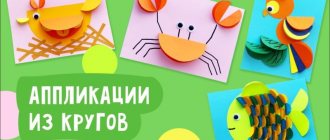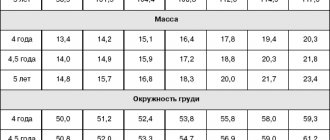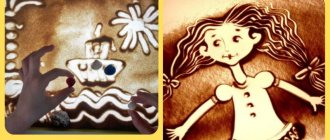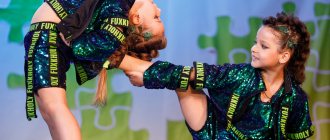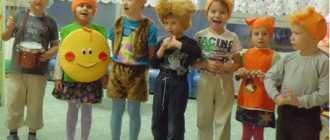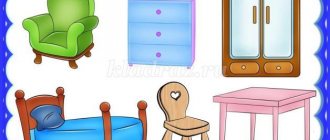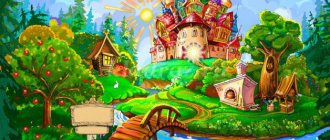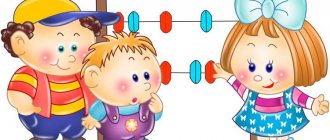Progress of the game
The teacher calls the children:
I'll sit next to you on the bench,
I'll sit with you.
I'll tell you riddles
I'll see who's smarter.
The teacher, together with the first subgroup of children, sits on the modules and looks at illustrations for riddles without words. Children choose pictures that they can make a wish without saying a word. The second subgroup at this time is located in another part of the hall.
Children of the first subgroup, without words , using facial expressions and gestures, depict, for example: the wind, the sea, a stream, a teapot (if it’s difficult, then: a cat, a barking dog, a mouse, etc.)
.
Children of the second subgroup guess . subgroup guesses , and the first guesses.
"ANIMALS"
Goal: To develop onomatopoeia skills in children.
Progress of the game
The teacher reads, the children imitate the movements.
Guys, look, a mountain of old dead wood. Oh, this is a den! And the cubs sleep in it. But then the sun warmed up and melted the snow. Droplets of water seeped into the den. Water got on the cubs' noses, ears, and paws.
The cubs stretched, snorted, opened their eyes and began to get out of the den. Spreading the branches with their paws, they got out into the clearing. The rays of the sun blind the eyes. The cubs cover their eyes with their paws and growl with displeasure. But soon my eyes got used to it. The cubs looked around, sniffed the fresh air with their noses and quietly scattered around the clearing. There are so many interesting things here! Further improvisation is possible.
GAME – PANTOMIME “THE HARE WAS A GARDEN”
Goal: to develop pantomime skills.
Progress of the game.
The object is placed on a chair in the center of the circle or passed around the circle from one child to another. Everyone must act with the object in their own way, justifying its new purpose, so that the essence of the transformation is clear. Options for the transformation of different objects:
a) pencil or stick - key, screwdriver, fork, spoon, syringe, thermometer, toothbrush, paint brush, pipe, comb, etc.;
b) a small ball - an apple, a shell, a snowball, a potato , a stone, a hedgehog, a bun, a chicken, etc.;
c) notebook - mirror, flashlight, soap, chocolate, shoe brush, game.
You can transform a chair or a wooden cube, then children must justify the conventional name of the object.
For example, a large wooden cube can be turned into a royal throne, flowerbed, monument, bonfire, etc.
“KING (version of the folk game)
»
Target. Develop actions with imaginary objects, the ability to act in concert.
Progress of the game.
Children hold hands and walk in a circle, in the center of which is the driver; children sing a nursery rhyme and perform movements.
At Malanya's, at the old woman's, (They walk in a circle and sing.)
Lived in a small hut
Seven daughters
Seven sons
All without eyebrows! (They stop and, using facial expressions and gestures, depict what is said in the text.)
With eyes like these
With ears like that -
With such noses
With such a mustache
With such a head
With such a beard.
We didn’t eat anything (They squat down and prop their chin with one hand.)
—
We sat all day.
On him (her)
looked
They did it like this. (Repeat any gesture after the leader.)
GAME – PANTOMIME “THE BEAR CUB”
Goal: develop pantomime skills
Goals and objectives of theatrical activities in the middle group
Theatricalization is considered as a means of developing speech activity, communicative, and artistic abilities of children in the middle group. As a rule, middle preschool age is a wonderful time to develop the creative talents of young children.
Goals and objectives of theatrical activities for students in the middle group
Already in the fifth year of life, preschoolers happily try on various roles of their favorite characters. They are impressed by fictional images (characters from cartoons, fairy tales). Over time, the children become more relaxed and understand the nature of human relationships.
Note! Each theatrical activity lesson is aimed at solving many problems that harmoniously develop a child aged 4-5 years.
Educational objectives according to the Federal State Educational Standard:
- Initially, the children are introduced to theatrical terminology. The children study varieties of theatrical art. They should have an idea of how to behave properly while in the theater.
- The conditions of theatrical play are focused on the stage space. Preschoolers learn how to move around the playground correctly. They also build dialogue with their peers. Setting up a specific topic requires special effort. Children must remember all the words and sentences of their favorite characters from a theatrical sketch.
- How the work on the performance is carried out. As early as the fourth year, children are taught to develop manipulative skills using imaginary objects. To embody specific feelings and experiences in a performance, you will initially have to create a certain image. Intonation, facial expressions and pantomime are especially helpful.
- Rhythmoplasty plays an important role. This is a kind of reaction to a musical signal or command. While performing the action, the guys must act in concert, remember various poses and convey them figuratively.
- It is necessary to develop speech culture. Preschoolers aged 4-5 years develop correct articulation and clear diction. The teacher must develop the ability to change intonation, compose short stories and fairy tales, and find elementary rhymes.
The preparatory development process considers the following tasks:
- Analysis of theatrical performance, which instills public speaking skills.
- The vocabulary is activated and the vocabulary is enriched. In order to clearly pronounce all the sentences in a theatrical sketch, it is necessary to improve the intonation structure and develop dialogic speech.
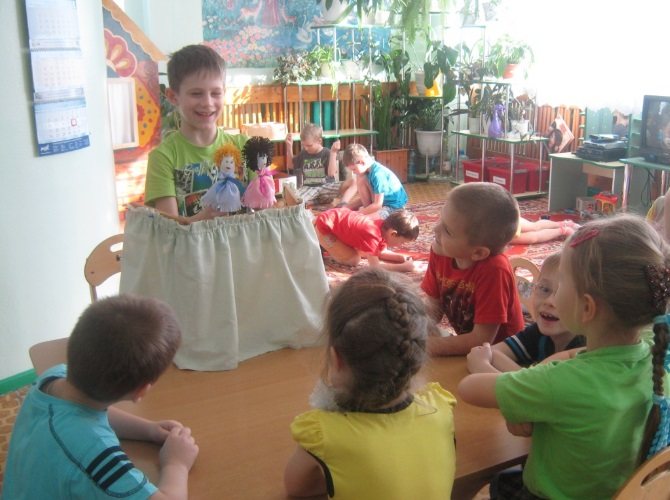
How to prepare for a performance and how a lesson is conducted at a preschool educational institution
You should also pay attention to educational tasks:
- Improving the general culture of preschoolers, introducing them to spiritual values.
- Theatrical activities contribute to the development of independence, artistry, and creativity. During the lesson, the child learns to communicate with his peers.
Note! The main goal is to introduce children to the magical world of theater. To do this, the teacher must prepare interesting theatrical performances. While completing all these tasks, children should know what the auditorium, orchestra pit, stage and other important details are.
Progress of the game.
Using a rhyme, a child is selected to play the role of king. The remaining child workers are divided into several groups (3 - 4)
and agree on what they will do and what work they will be hired for.
Then they approach the king in groups .
Workers. Hello King!
King. Hello!
Workers. Do you need workers?
King. What can you do?
Workers: Guess it!
Children, acting with imaginary objects, demonstrate various professions: cooking, washing clothes, sewing clothes, embroidering, watering plants, etc. The king must guess the profession of the workers. If he does it correctly, he will catch up with the fleeing children. The first child caught becomes king. Over time, the game can be complicated by introducing new characters (queen, minister, princess, etc.), as well as inventing the characters of the characters (king - greedy, cheerful, evil; queen - kind, grumpy, frivolous).
"GRANDMOTHER MALANYA"
Goal: To develop attention, imagination, resourcefulness, the ability to create images using facial expressions, gestures, and plasticity.
